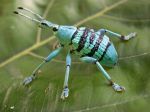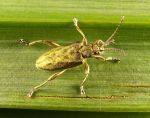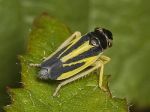Research interests:
I have broad research interests in population and community ecology, especially of insects. A unifying theme running through the various projects in which I have been involved is how fundamental ecological principles can be used to assist the conservation of rare and endangered species and the preservation of biodiversity both in the UK and overseas.
Determinants of species diversity in tropical rain forest insects:
 I have been working since 2001 in collaboration with Professor Vojtech Novotny and the Binatang Research Center in Papua New Guinea on rainforest insect diversity. Our research has especially addressed such questions as: how many species of insect are there in tropical forests (and, by extension, the world)?; how host-specific are insect herbivores?; how fast, and to what extent, can the structure and diversity of such rainforest insect communities be restored after major disturbances such as logging or open-cast mining? I have also worked on methods for biodiversity assessment in Fiji. Currently, we are working on how best to develop sustainable livelihoods for remote rainforest communities that are faced with a choice between forest conservation and logging concessions by building capacity (infrastructure, management expertise and para-ecologist teams) for internationally-networked biodiversity research. Our work both in Papua New Guinea and Fiji has been generously funded by the UK Darwin Initiative.
I have been working since 2001 in collaboration with Professor Vojtech Novotny and the Binatang Research Center in Papua New Guinea on rainforest insect diversity. Our research has especially addressed such questions as: how many species of insect are there in tropical forests (and, by extension, the world)?; how host-specific are insect herbivores?; how fast, and to what extent, can the structure and diversity of such rainforest insect communities be restored after major disturbances such as logging or open-cast mining? I have also worked on methods for biodiversity assessment in Fiji. Currently, we are working on how best to develop sustainable livelihoods for remote rainforest communities that are faced with a choice between forest conservation and logging concessions by building capacity (infrastructure, management expertise and para-ecologist teams) for internationally-networked biodiversity research. Our work both in Papua New Guinea and Fiji has been generously funded by the UK Darwin Initiative.
Community and restoration ecology of temperate grassland insects
Insect communities in temperate grasslands can be very diverse. I am interested in what factors determine the composition and diversity of such communities (working especially on the Rothamsted Park Grass Experiment), the extent to which these communities change over time, how management practices such as grazing affect community composition, and how the species diversity of certain grassland types (especially chalk grassland) can be restored after they have become degraded (e.g. from intensive arable, scrub or low-diversity agriculturally-improved grassland).
Insect species conservation
 Many insect species in Britain are rare and/or declining for a variety of complex reasons. I am interested in und
Many insect species in Britain are rare and/or declining for a variety of complex reasons. I am interested in und erstanding the determinants of commonness versus rarity and how best to conserve species that are vulnerable. In this context, I have worked in particular on the conservation of reed beetles in the genus Donacia, the glow worm Lampyris noctiluca, and the Biodiversity Action Plan leafhoppers Doratura impudica and Erotettix cyane.
erstanding the determinants of commonness versus rarity and how best to conserve species that are vulnerable. In this context, I have worked in particular on the conservation of reed beetles in the genus Donacia, the glow worm Lampyris noctiluca, and the Biodiversity Action Plan leafhoppers Doratura impudica and Erotettix cyane.
Ecology, biogeography and conservation of leafhoppers and planthoppers
The Auchenorrhyncha (leafhoppers, planthoppers, froghoppers, treehoppers and cicadas) are sap-sucking bugs (Hemiptera) that frequently are numerically  abundant and form species-rich assemblages in a variety of habitats, especially grasslands, woodlands and mires. I am interested in the extent to which the composition of such assemblages can be used to indicate site quality, disturbance and restoration. I organise the national Auchenorrhyncha Recording Scheme, which seeks to promote recording of this group (through identification workshops, on-line recording, newsletters etc.) and to understand the biogeography of the c.400 species that occur in Britain and Ireland. I have also had a number of projects on the conservation of individual species (see above). Currently, we are working on the ecology of the planthopper Prokelisia marginata that feeds on salt marsh cordgrass (Spartina anglica). This native of North America has recently colonized Britain and spread widely around salt marshes in England and Wales.
abundant and form species-rich assemblages in a variety of habitats, especially grasslands, woodlands and mires. I am interested in the extent to which the composition of such assemblages can be used to indicate site quality, disturbance and restoration. I organise the national Auchenorrhyncha Recording Scheme, which seeks to promote recording of this group (through identification workshops, on-line recording, newsletters etc.) and to understand the biogeography of the c.400 species that occur in Britain and Ireland. I have also had a number of projects on the conservation of individual species (see above). Currently, we are working on the ecology of the planthopper Prokelisia marginata that feeds on salt marsh cordgrass (Spartina anglica). This native of North America has recently colonized Britain and spread widely around salt marshes in England and Wales.
Control of insect pest species
I am interested in developing biological control methods for the suppression of insect herbivore pests. Such work invariably requires a detailed understanding of insect life histories, population dynamics and interactions with their hosts and natural enemies. A recent example is the control of Phyllobius leaf weevils that can cause extensive damage to trees in newly-planted farm woodlands.


